Sandwich Island Composites (S.I.C.) New F-18 by Mark Raaphorst
We have asked Mark Jackson, to give us his views on the F18. Here is the review of his two F18 boards (flat water and a channel board) both of which he is extremely pleased.
With flat water club racing and both coastal and channel crossings becoming popular, stand up race boards are becoming more exotic and user specific. Both my F18’s were designed and shaped by Mark Raaphorst and built by the Sandwich Island Composites (S.I.C ) dream team.
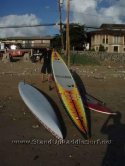 18’8″ Australian Penetrator side by side with S.I.C’s F18
18’8″ Australian Penetrator side by side with S.I.C’s F18
When ordering my boards, I kept my input to a limit and let Mark build on instinct and insight. It’s been a good decision, both boards are exceptional and the next generation which have long been out (Mark is loaded with orders) are improvements on an already fantastic board. Proof of this lies in the paddling as well as the pudding. Randy Strom of www.standupzone.com has ordered an exact replica of my board only in all carbon. Shit…now the bastard will kick my ass on Maliko runs and his wife (Channy) will probably kick both our asses.
The Channel Crossing board I have is 17’4″ x 27 1/2 x 4 3/4. Weighed around 30 lbs. before I trashed it with the help of other board tester’s %^$#…now it’s around 32 lbs. Standard deck (not drop decked) hard straight rails, short cut off tail with subtle vee. The best review I can give of this board without dribbling on about hull shape, rocker line and rail profile, is to offer your readers results and comments from other riders.
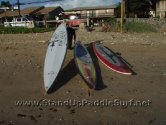 Close-up of the F18 full volume rails and small amount of nose rocker
Close-up of the F18 full volume rails and small amount of nose rocker
Dave Kalama took this board on its maiden voyage to Oahu after doing a quick demo run from Maliko to Kahalui Harbor. The board he planned to race in the Molokai to Oahu race took a whack and sucked up water. He rode mine instead. His results speak for him, his cousin, and the board. I think he won by a margin of around half an hour or so, on the next team. He called to thank me for the use of the board. I asked, “What did you think of the board?” Within his modest reply was the statement…once that board gets up and goes…it’s gone!!! Since then, every rider has raved about it and Randy and I have posted respectable times of 1 hr. 21 from Maliko to the Harbor. Not bad for a fat Kiwi and a skinny New York punk.
The board works best in classic North Shore Maui. The windier and gnarlier the better. It has a “swappable” rudder configuration. I’m goofy…(footed I mean) Raaphorst set it up so it can go natural or goofy. Dave is natural footed so Mark “swapped” over the wires.
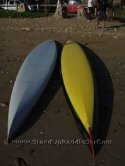 The S.I.C. F18 and Penetrator bottom view
The S.I.C. F18 and Penetrator bottom view
What I like most about the board is when it’s amping out down a big wind swell it’s as stable as a Ferrari on a straight away. Stand on the tail and enjoy a freight train ride gliding at speeds over ten knots, (Garmin log to prove it.) What I don’t like about the board is that Randy is gonna get the same sweet deal only in full carbon. Yeah I’d like the weight to be less. Too much weight kills acceleration, which is what you need to punch into glides. I referenced this to Mark for my F18 Flat water board.
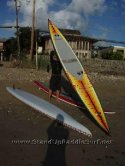 Showing off the 18’8” Australian Penetrator’s deck
Showing off the 18’8” Australian Penetrator’s deck
Mark built my next board without any “extras”: no handles, leash plugs, limited pads and primmer only. End result- light and fast!!!
Again, I let Mark be Mark. EuroMan or Bust, and he designed it head to toe. The guy nailed it. I can’t review this board unbiased. Sorry I’m about as biased as Rush Limbo dancer. “How low can you go?” This board has beaten the Penetrator in two flat water races on the MCKC (Maui Canoe and Kayak Club) schedule, clocked times on flat water coast runs substantially faster than just about any other board, out run a tiger shark and it makes great coffee. The board has a gun nose and tail, very little rocker, flat bottom and softer rails. Again, a verbal description of its profile outline etc. is limited in giving perspective on the board. Ridding it in flat water in a slight headwind against other boards is cheating. It gets on a glide and stays there effortlessly. I use a small 8 1/4″ Kanaha blade, which effortlessly accelerates the board thru the water. It glides like a Stein lager down your neck after two Stein lagers as a primer…sweet.
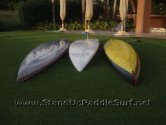 Comparing rails and rockers with the F18,
Comparing rails and rockers with the F18,
This board weighs about 27 lbs. is 17′ 8″ and 28″ wide. Main characteristic: flat flat flat. Mark has built another one wider and with a different hull shape. In the last Maliko race (Feb. 21st) of the MCKC race series, Mark used this board and flogged the lot of us. Mind you, this time I think he wore his spectacles and could see were he was going. Also, he managed to pull out 80% of the Vana he drilled into his foot from the last race when the Wally tried to surf tiny waves on a dry reef with an F14 at Grandmas. Euro kook!!!
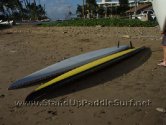 Mark Raaphorst’s F18 side by side with the 18′ 8″ Penetrator.
Mark Raaphorst’s F18 side by side with the 18′ 8″ Penetrator.
If I really try not to be biased about this board then I’d say it’s a little unstable. On a heavy day, Maliko to Kahalui, it’s a bit more of a balance battle than the channel board. Alan Cadiz rode it on such a day and Ke Nalu did a heli shot of the trip. Alan liked it but made comment about it “sticking the bow” no doubt because of the boards’ rocker.
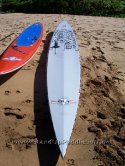 The F18: a high-performance open ocean racer
The F18: a high-performance open ocean racer
All in all I think the F18 series is a winner and we’re gonna see a few more custom, one off, pop out of S.I.C. Ding King. What’s remarkable about the F Series boards is variety. Not only does S.I.C. (Sandwich Island Composites) offer hollow molded production 14′ and 16′ race boards. They can also build to your exact specifications. From shape size and weight to colors and graphics.
Get up Stand Up and always hang loose.
– Mark Jackson
Here is the specification of the latest high-performance open ocean racer from Sandwich Island Composites (S.I.C), the F18 by Mark Raaphorst.
Size: 17’6″ X 28″
The Hull:
It has a canoe type nose entry to knife through the water. Under your feet it has a 23″ flat section to create enough board stability. This flat section extend almost all the way through the back.
The Rocker
Maximum waterline is the key to a fast and low friction displacement board. It has a small amount of natural curve throughout the board. When a 190 pound person is standing on it the nose and tail are touching the water.
The Deck
The bow section has a “V” to expel water in case you do poke into an upcoming swell. The deck area where you mainly stand has a slight bit of a double concave (1/4″) for feet comfort. The concave is not noticeable to the naked eye unless you put a straight edge on the deck. The rear part of the deck is flat.
The Rails:
Full volume. Well rounded undertuck. No hard edges anywhere. The bow has a splash rail chine that prevent water from sticking to the rail and traveling up onto the deck.
The Pad:
Minimum size and thin to save on weight.
The Construction:
1 pound density styrofoam.
Bottom has 1- 6 Oz. carbon plus 1- 6 Oz Glass
Rail have extra carbon plus/minus 45 degree stiffener strips
Deck has 1- 6 Oz. carbon plus 1- 6 Oz Glass plus plywood veneer heel reinforcements.
The Steering:
The Active Steering System (ASS) will be positioned for regular or goofy footer or upon request plumbed for duo (resale).
It has a 5″ adjustable insert placement for the foot paddle pivot point. (back and forward). It comes with a spring loaded fiberglass batten so when you step back and surf, the rudder will come back to the straight position.
The rudder is a molded 9 1/4″ spitfire type (straight up and down) design. It has a foil for medium speed (5 to 15 MPH) efficiency.
Cables are tension adjustable with a turn buckle in the rear.
All hardware is stainless steel and molded carbon.
The Weight: approximately 30 pounds.
Color:
We recommend a light grey primer bottom. It is light, fast and has little friction due to the ultra fine sanded surface.
The deck can be any color. We do not recommend the dark color spectrum. In the sun they heat up.
Cost:
Without steering $2700
With Steering $3075
Shipping:
Inter island pick up at the YB dock is $30
West coast by air in 5 days to your location: $300
West Coast by Matson Ocean Freight appr. $200
Australia by air appr. $700
East coast by air : call for a quote (cost depends on the trucking portion of the freight)
Travel board bags:
Custom fitted travel bags made by Da Kine Hawaii. Cost is $325
.
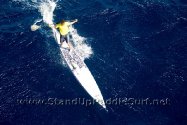



I’ve got a dumb question.
If the board is laminated with one layer carbon and one layer fiberglass, top and bottom, how will Randys all carbon model come out weighing less? Will it be one layer only top and bottom?
Carbon and fiberglass are rated the same 5.6 oz per sq yd.
I’m asking, because I just built my first board in my garage.
I asked Mark J and Mark R to answer your question.
Hi Dwight.
Firstly and most importantly, Kudos on the bold move to build your own board in your garage. Unfortunetly I must defer your question to Mark Raaphorst. I’m not certain how Mark and Randy Strom have decided on the lay up. My guess is that carbons strength permits (as you deduced)one v’s two layers. Resin saturation also could be part of the lighter build, if carbon requires less resin.
As a “backyard builder” check out wikipedia online by typing in carbon fibre cloth weight comparison in google, there’s a great in depth article on carbon composites.
Shape On.
Aloha MJ.